Matador Network's Blog, page 540
January 20, 2022
Escape Amsterdam for the perfect psychedelic truffles trip in the Dutch countryside
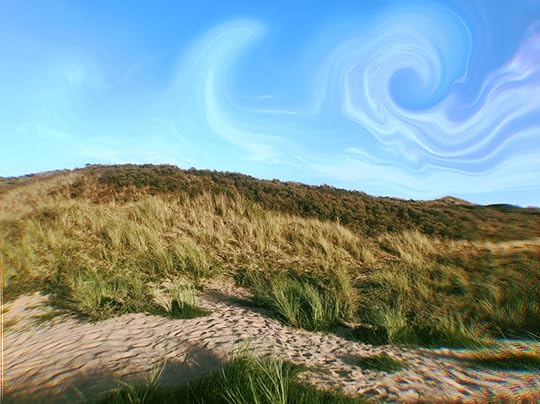
Tourists from around the world travel to the Netherlands to explore the country’s charming canals, gaze upon the blossoming tulip fields, and perhaps experiment with mind-altering hallucinogens.
While thousands of curious psychonauts understandably embark on their first visionary experience on the winding streets of Amsterdam, the beautiful windmills, flowers, quaint towns, and dune landscapes found in the countryside should not be overlooked. After all, a psychedelic experience in the Netherlands’ vast fields and endless beaches can open up one’s mind in a way that cities cannot. This guide will give you a rundown on how to prepare and what to expect from a psychedelic experience in the Dutch countryside.
Preparing for the tripMagic mushrooms versus magic trufflesJust like how cannabis is technically illegal, mushrooms are also illegal in the Netherlands. However, a technicality in the drug law allows for legal consumption and sale of truffles in smart shops, and they’re the go-to psychedelic in the Netherlands is truffles.
Truffles are the sclerotia of psilocybin mushrooms. In simple terms, the truffle is the subterranean part of the mushroom. Both mushrooms and truffles contain the psychedelic compound psilocybin and provide the same visionary experience.
Buying magic trufflesDozens of smart shops can be found in Amsterdam if you prefer to pick them up in the city (make sure not to confuse them with coffeeshops, which sell cannabis). Cities like Rotterdam, The Hague, and elsewhere also have smart shops throughout.
Magic truffles come packaged in small boxes with fantasy names like Atlantis, Utopia, Pandora, and so on. A creative description alludes to the type of experience the truffle provides. The enchanting names and vivid descriptions are marketing tactics and trade names, not botanical terms. In reality, there is little difference between the truffle varieties except for the intensity and duration. Regardless, the descriptions can create a positive expectation bias. If the description promises a gleeful trip filled with laughter and elation, you’re more likely to experience it. If you have questions, the shopkeepers will be more than happy to help.
Set and setting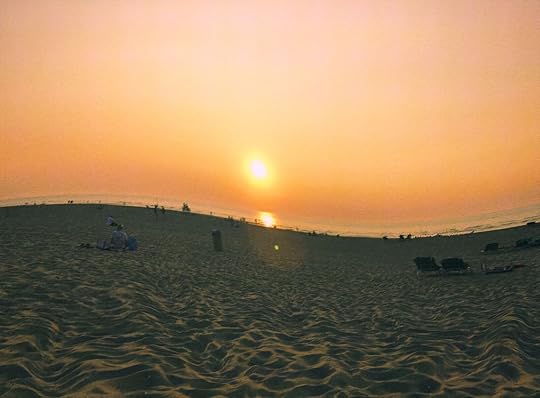
Photo: Olivia Persson
The mantra for psychedelic trip preparation is set and setting. Intentional set and setting can be the difference between a visionary experience or an uncomfortable few hours.
Set is short for mindset and refers to how you’re feeling. Make sure you’re in a good mindset before embarking on a psychedelic experience. Psychonauts recommend setting an intention for the trip. Exploring an unfamiliar state of consciousness and connecting to nature is an intention. Laughing, chilling out, and just having a good time with your friends is also a valid intention. Setting intentions can serve as an anchor if the psychedelic experience takes a confusing turn.
Setting is the physical and social space the trip occurs in. A comfortable physical space is crucial. Tripping outdoors in nature is vastly different to tripping indoors, and each has its merits. If you are tripping outdoors, a comfortable shelter nearby is recommended. It’s also advisable to carry water and light snacks in a backpack. Luckily, in the Dutch countryside, you are never too far from civilization.
Finding nature in the NetherlandsAs the most densely populated country in the European Union, pristine nature is not always easy to come by in the Netherlands. However, Dutch urban planning and conservation ensures that green oases and biodiverse landscapes are always nearby.
The Wadden Islands in the north are home to the most pristine natural landscapes. Vast barren dunes of Schiermonnikoog and Texel are reminiscent of an alien landscape. The spellbinding islands are easily navigable, sparsely inhabited, and accessible — the perfect setting to let your mind wander.
The Wadden Islands are not your only options. Plenty of urban nature reserves are scattered across the Netherlands. Truffles can transform even the most humble parks into majestic wonders.
In Amsterdam, a walk in Rembrandtpark and Amsterdamse Bos will take you back in time. Simply lay in the grass, watch the clouds pass, and listen to the sound of leaves fluttering in the wind. It is truly something else.
If you are fond of the ocean and dunes, you must visit Scheveningen Strand, a seemingly endless beach on the outskirts of The Hague. Listening to the sounds of the roaring waves and feeling the powerful winds of the North Sea while tripping is enough to humble you. Alongside the beach is Meijendel, an underrated coastal dune nature preserve.
What to expect on a truffle trip
Photo: Olivia Persson
There are several ways to consume the truffles. You can either eat them raw, brew them in a tea, or use the lemon tek method. The experience usually lasts around four to six hours. Expect the trip to unfold itself in waves, giving you a chance to ground yourself before the next wave hits.
It is recommended to consume truffles on an empty stomach for the full effects. If you’re consuming the truffles raw, keep in mind that the taste is unappetizing, to say the least. Dark chocolate is often used to mask the taste.
The psychedelic effects appear after about 30 minutes to one hour. If the effects do not appear, do not consume more than you think you can handle. Be patient, and it will unfold. You may also feel nausea during the come-up, which is normal and will pass.
Truffles can significantly alter your senses. As a friend once shared, “I remember seeing the world like this when I was a child.” Heightened perception, a feeling of love and interconnectedness, gratitude, joy, and laughter are common. Dunes may sing, geometric patterns may overlay the waves, and towering trees may breathe. Embarking on the psychedelic experience in nature is like stepping into a groovy fairy tale.
Walk around, laugh with your friends, explore, adventure, and tap into that childlike curiosity. It’s a powerful experience, and it is also an experience that one should not take too seriously. The experience can help you resolve issues if you let it, and it can help you connect with yourself, your loved ones, and the natural environment. If the experience is hard, one should not fight it. A change of environment, a beautiful playlist, or the support of a friend is enough to reorient the trip positively.
Safety and serenity are in abundance in the Dutch countryside. You can have an amazing experience in the alluring and strange landscapes. Let the Dutch landscapes open up your mind and heart. You never know what you’ll find.
More like thisLifestyleEverything you need to know about doing magic mushroomsBritain will no longer require COVID-19 testing for vaccinated travelers
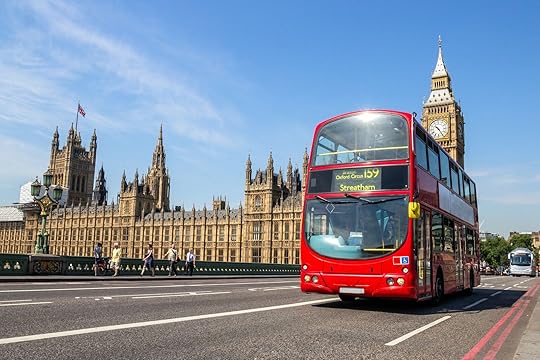
Getting into Britain will soon be much easier for travelers. The region is set to drop Britain’s COVID-19 testing requirement for fully vaccinated travelers by the end of January, according to The Times. The official announcement is set for January 26.
With the Omicron surge, the region strengthened restrictions to contain the virus. However, now that daily infections are rapidly declining, Prime Minister Boris Johnson is expected to end almost all pandemic restrictions like the work from home guidance and vaccine passports used for nightclubs and events with large crowds. The UK reported 108,069 new positive cases on Wednesday, compared to the 218,724 reported two weeks prior. The requirement for face masks on public transportation is expected to stay in place until at least the end of cold and flu season. However, many UK officials worry that removing these restrictions may set Britain up for another Omicron surge.
“The NHS is under significant pressure,” Matthew Taylor, CEO of the National Health Services Confederation said according to Forbes. “Even with restrictions and many people going further to protect themselves and others, the number in hospital with COVID is high, and the numbers are only going down very slowly. High numbers of COVID patients and staff off sick has an inevitable effect on the work the health service can do, including the urgent task of making inroads into the treatment backlog and getting back to key performance targets.”
Earlier this month, Britain only required its citizens to test once they returned to avoid being barred from re-entry when returning home. Pre-departure testing was suspected to be putting people off. Airlines in the UK endorsed the government’s decision, calling it an essential step towards “learning to live alongside the virus.” Travelers also no longer need to take a PCR test and can substitute it with a rapid antigen test before the second day following arrival.
Note that unvaccinated or partially vaccinated travelers will still need to take at least three COVID-19 tests and self-isolate for 10-days upon arrival. Travelers heading back to the US will still need to take a COVID-19 test up to three days prior to departure. 
Shrimp paste is the bold Indonesian ingredient your pantry needs

Indonesian food is complex and dynamic: It can be spicy, sweet, sour and savory, sometimes all at once. These tantalizing flavors come from the different bumbu, or spice mixes, and other essential ingredients, like shrimp paste, that are used in preparation of many classic Indonesian dishes.
Indonesian cuisine can sometimes be difficult to define, however, because it consists of a mix of different regional culinary traditions. The country is made up of over 17,000 islands, so you can imagine just how much variety there is when it comes to recipes. Colonization and migration added Indian, Chinese, Portuguese and Dutch culinary influences to an already diverse and varied cuisine.
There are some ingredients that are consistent across most Indonesian recipes. One of the most important is shrimp paste, one of the foundations of Indonesian cuisine. It’s an essential addition to dishes because it provides that essential umami flavor that is so recognizable in many Indonesian dishes across the archipelago.
I grew up in Lombok, Indonesia, where my parents had a small homestay. I used to spend each day in the kitchen, learning from (and sometimes getting in the way of) the cooks. I remember them always reaching for the plastic-looking block of shrimp paste when preparing each meal — just a small, thumb-sized piece would be enough to flavor a dish. It was the foundation on which every recipe was built.
Sometimes, they would roast the shrimp paste over an open flame. Not only does this bring out the aroma and flavors of the shrimp paste, but it also kills any bacteria or pathogens in the raw shrimp paste. Other times, spoonfuls were dropped straight into the wok, sizzling away with shallots, chillies and garlic, filling the kitchen with an aroma that made my stomach rumble.
I grew up eating these traditional Lombok dishes and Indonesian cuisine every day. Pelecing (water spinach topped with chilli sauce and grated coconut), tempe teri kacang (tempe, dried anchovies and peanuts tossed in a sweet and spicy sauce) and curries were (and still remain) some of my favorites. These are my comfort foods.
Naturally, when I moved to the UK for university, I had to bring packets of shrimp paste with me. Although you could source these in the Asian supermarkets in most cities, there was something comforting about bringing this paste (specifically lengkare) all the way from home — a little taste of Lombok. To cook an Indonesian dish without shrimp paste just doesn’t make sense. If you want to try it out yourself, and experience the explosion of salty and pungent umami that this ingredient offers, here’s everything you need to know about shrimp paste.
What is shrimp paste?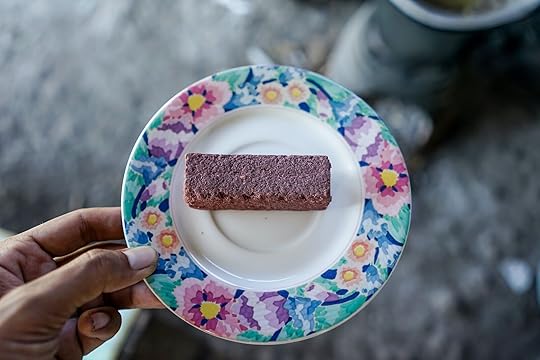
Photo: Oka diana/Shutterstock
Indonesian shrimp paste is called terasi, and is usually made from acetes, a tiny shrimp which is native to the west and central Indo-Pacific ocean. Shrimp paste is salty and pungent, used either as a condiment or an ingredient in a recipe.
The acetes are sometimes formed into large blocks, but can also be sold as a coarse, ground powder or a thick sauce. The consistency determines how you cook with it — thinner versions are easier to stir into dishes, whereas firm blocks will require pounding. Just make sure the shrimp paste is cooked and completely dissolved before serving.
The color of shrimp paste changes depending on its country of origin, and can range from a pale pink, to a purple-reddish shade, or even dark brown.
There are three main types of shrimp paste in Indonesia, which are made from different ingredients depending on where you are. In Cirebon, a city in West Java, shrimp paste is made from rebon, a type of shrimp that is so abundant that it inspired the city’s name. When rebon is mixed with palm sugar it becomes petis, another type of shrimp paste which can also be made with tuna. In Lombok, an island to the east of Bali, you’ll find lengkare, a sweet and savory version of shrimp paste.
What is the difference between Thai, Filipino, and Vietnamese shrimp paste?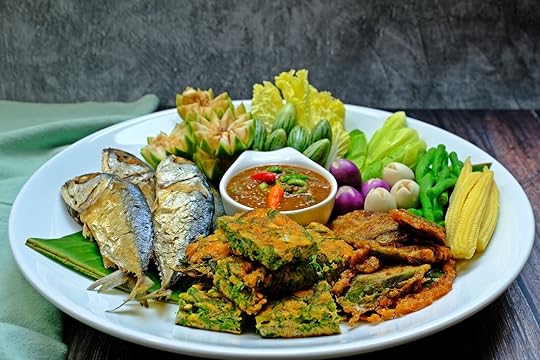
Photo: Supratchai Pimpaeng/Shutterstock
There are so many varieties of shrimp paste depending on where you are in Asia, with differences in smell, taste and saltiness. While I was enjoying lengkare in Lombok, there are a multitude of other options around this corner of the globe.
For example, Thai shrimp paste is called kapi. It’s used in curry pastes and spicy dips and sauces like nam phrik. Southern Thailand actually has three types of shrimp paste — one made just with shrimp, one mixed with other fish ingredients and one which is sweet. Mun kung is a common Thai ingredient which is often confused for shrimp paste, and not just because it translates as ‘shrimp paste’. Mun kung is actually the fat from the head of the shrimp, sort of like a shrimp pate, oily and orange in colour.
Meanwhile in the Philippines, bagoóng alamáng is made from the same type of shrimp used in Indonesian terasi and Malaysian belacan. It’s used in all kinds of recipes, whether that’s in stir-fries, fried rice, as a topping on fresh mangoes or in binagoongang baboy, a pork and shrimp paste stew.
In Vietnam, shrimp paste is known as mắm tôm. There are two varieties: one is a thick paste and the other has a runnier, sauce-like consistency. It’s used in dishes like bun bo Hue (Hue-style beef noodle soup) and as a sauce in stir-fried pork belly and sauteed seafood. It’s also prepared as a dipping sauce when mixed with lime juice, sugar, kumquat and chilli.
Indonesian dishes that use shrimp paste
Photo: Fadhli Adnan/Shutterstock
One of the most common uses of shrimp paste is in sambal. This chilli sauce is a must-have condiment on every table — ask any Indonesian and they’ll say their meal feels incomplete without sambal. It’s served with everything from national dishes like nasi goreng (fried rice) and soto ayam (chicken noodle soup), to grilled meats and snacks. There are many types of sambal across the country, but they typically incorporate chillies, tomatoes, shrimp paste, garlic and salt, with the optional addition of shallots, ginger and tamarind.
As well as sambal, shrimp paste is used in a sauce for rujak, a popular snack of Javanese origin but also found in Malaysia and Singapore. Unripe fruit such as mango, papaya and pineapple are served with a spicy and nutty palm sugar dressing.
Thanks to complex and spicy sauces in Indonesian cuisine, even the simplest vegetable dishes taste phenomenal. It’s how they’re cooked with the combination of herbs, spices and sauces that makes them so delicious. You’ll find shrimp paste is used in several vegetable dishes such as sayur asem (sour and spicy vegetables in a tamarind broth), karedok (raw vegetable salad in peanut sauce) and urap (steamed vegetables mixed with spiced grated coconut).
Sate, or satay, is another popular national dish. It’s essentially just seasoned meat or fish on a skewer, grilled over an open flame and served with a sauce. There are so many variations of this using different herbs, spices and sauces that it’s impossible to name them all but one of my favorites is sate lilit. It’s a Balinese version made with minced meat or fish and mixed with grated coconut, coconut milk, lemon juice, shallots, shrimp paste and local herbs and spices.
Bookend your Disney trip at these beautiful Orlando airport hotels

If you’re booking an Orlando airport hotel, you’re likely either coming or going to Disney World, Universal Orlando Resort, a work conference, family reunion, or some combination of the above (bravo to you, if that’s the case). Whatever the reason, bookending your Orlando trip with an airport stay is the most convenient way to ensure you aren’t rushed getting in and out of town, and have time to actually step away from the scene and relax a bit. These are the best Orlando airport hotels for every major hotel rewards program.
We hope you love the Orlando airport hotels we recommend! Just so you know, Matador may collect a small commission from the links on this page if you decide to book a stay. Listed prices are accurate as of the time of publication. See our full Advertiser Disclosure here.
Headliner Orlando Airport hotelTop Marriott Bonvoy Orlando airport hotelsTop Hilton Honors Orlando airport HotelsTop Wyndham Rewards Orlando airport hotelsTop IGH Rewards Orlando airport hotelsHeadliner Orlando Airport hotelHyatt Regency Orlando International Airport Hotel

Photo: Booking.com

Photo: Booking.com
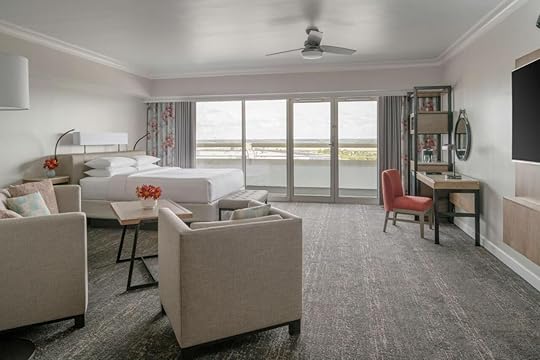
Photo: Booking.com

Photo: Booking.com
Located in the airport’s main terminal, the Hyatt Regency Orlando International Airport hotel is a piece of luxury removed from the hectic Disney scene – but convenient to it nonetheless. What separates this Orlando airport hotel from other airport hotels is that it features a year-round outdoor pool, an amenity not possible in colder climates and overlooked frequently even in warmer ones. Why stay at an Airbnb near Disney World when you have an early flight out — or a late flight in?
The Hyatt Regency features onsite dining and has the feel of a resort, all within the airport. There’s no fear of oversleeping and missing your flight when the security checkpoint is literally a stroll from the check-in desk. Just don’t forget to enjoy the hot breakfast on the way out. The pancakes are extra fluffy in the thick Florida air.
Price: From $199 per night
Top Marriott Bonvoy Orlando airport hotelsMarriott Orlando airport Lakeside

Photo: Booking.com

Photo: Booking.com
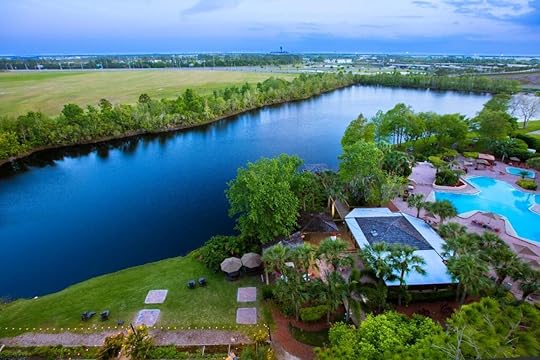
Photo: Booking.com

Photo: Booking.com
How about a visit to the hotel’s pool bar to cap your Disney World trip? This is possible here at the Marriott Orlando Airport Lakeside. Comfortable rooms and a spacious lobby lounge area complement the top-notch pool experience here. Take advantage of the hot tub and dine at the Crimson Tavern, located inside the hotel and serving the best meals within a stone’s throw of the airport. Post up over your laptop at the Coffee Bean and Tea Leaf to get a day’s work done before heading out for your flight.
Airport shuttle: Yes24-hour front desk: YesFitness center: YesPrice: From $174 per night
Courtyard by Marriott Orlando Airport
Photo: Booking.com

Photo: Booking.com
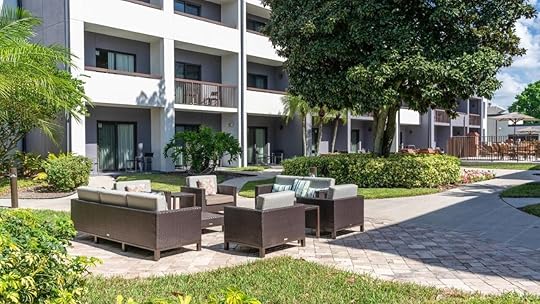
Photo: Booking.com

Photo: Booking.com
Add an apartment feel to your Orlando airport hotel stay at the Courtyard by Marriott Orlando Airport. All rooms have a balcony, many overlooking the pool. Rooms are ideal for both long and single-night stays, with in-room workstations and lounge areas. The hotel’s market is open at all hours, and the onsite restaurant serves breakfast, lunch, and dinner. This hotel is the perfect bookend to a Kissimmee Airbnb or Disney World stay.
Airport shuttle: Yes24-hour front desk: YesFitness center: YesPrice: From $108 per night
Top Hilton Honors Orlando airport HotelsHilton Garden Inn Orlando Airport

Photo: Booking.com

Photo: Booking.com

Photo: Booking.com
Hotels near the Orlando Airport have one thing in common — Southern hospitality. The Hilton Garden Inn Orlando Airport takes said hospitality and adds the best hot breakfast buffet in Orlando. Choose from s smorgasbord of options ranging from staples like eggs and bacon to a variety of potatoes and cooked-to-order items. And the hotel has everything else you need for a quality stay as well — clean and comfortable rooms. Kitchenettes. A nice pool. Gorgeous Florida weather and the sound of turbojets valiantly soaring overhead. There’s even a mini kids’ waterpark. Garden Inn is an iconic part of Hilton’s portfolio, at the Orlando airport location is a stellar example of why.
Airport shuttle: Yes24-hour front desk: YesFitness center: YesPrice: From $100 per night
Homewood Suites by Hilton Orlando Airport
Photo: Booking.com

Photo: Booking.com

Photo: Booking.com

Photo: Booking.com
If traveling on a romantic holiday, for business, or otherwise when a refined bit of extra space is necessary, Homewood Suites by Hilton Orlando Airport is a strong option. It’s a great place to settle into after (or before) an intense trip. Post up by the lobby fireplace and enjoy conversation (or a work session), hit the pool, or grab a drink and chill by the outdoor fire pit. In-room, enjoy a full kitchenette with dishwasher, and a lounge space with TV. Check out the free food and the welcome reception, and don’t forget to stop by the hot breakfast on your way to the airport.
Airport shuttle: Yes24-hour front desk: YesFitness center: YesPrice: From $166 per night
Top Wyndham Rewards Orlando airport hotelsLa Quinta by Wyndham Orlando Airport North
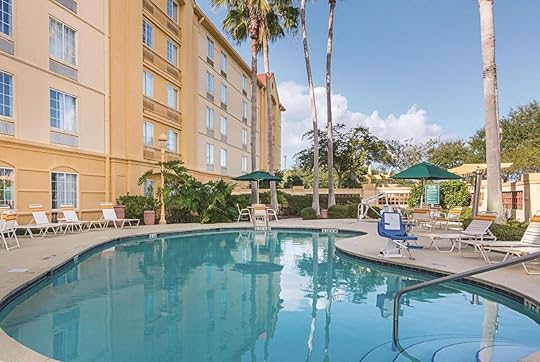
Photo: Booking.com

Photo: Booking.com

Photo: Booking.com
La Quinta by Wyndham Orlando Airport North is the closest hotel on this list to both Walt Disney World and to Universal Orlando Resort. Both are less than 20 minutes’ drive, a notable convenience given that the airport itself is also less than five minutes away. Onsite, enjoy the clean and simple rooms that are a step up from the run-of-the-mill chain hotel. Suites are available, as is breakfast and a fully stocked business center. It’s on par with the best La Quinta has to offer, and a great place to bookend your trip to Disney World or conference in the Orlando area.
Airport shuttle: Yes24-hour front desk: YesFitness center: YesPrice: From $113 per night
Wyngate Garden Orlando Airport
Photo: Booking.com

Photo: Booking.com

Photo: Booking.com
Contemporary. Hip. Top-not concierge. These three phrases define the Wyngate Garden Orlando Airport. Take advantage of the Sun Terrace, the deck-with-an-epic-view that separates this property from other Orlando airport hotels. That, and the fact that you can settle into a lobby bar that is as warm and welcoming as the rooms. Church Street Station and much of Orlando’s dining scene is a quick Uber ride from the hotel. The Disney and Universal resorts are just over 20 minutes’ drive.
Airport shuttle: Yes24-hour front desk: YesFitness center: YesPrice: From $100 per night
Top IGH Rewards Orlando airport hotelsHoliday Inn Orlando International Airport Hotel

Photo: Booking.com

Photo: Booking.com

Photo: Booking.com

Photo: Booking.com
Holiday Inn set the bar for the American hotel chain. The Orlando airport hotel branch is a good example of why Holiday Inn remains a mainstay. Its open, remote-work-friendly lobby beckons for conversation and a laptop session. The palm-lined pool is resort-worthy. The bar pops at least a couple nights a week, as much as airport hotel bars tend to do. And the in-room experience is simple, efficient, and clean. You know what you’re getting into, and this Orlando airport hotel won’t disappoint.
Airport shuttle: Yes24-hour front desk: YesFitness center: YesPrice: From $122 per night
Staybridge Suites Orlando South
Photo: Booking.com

Photo: Booking.com

Photo: Booking.com

Photo: Booking.com
Staying at a Staybridge Suites is like visiting that friend you had in college that always seemed to have a slightly nicer apartment than you. You think, “Oh, I won’t be wowed, it’s just another place. I’m used to it.” But then you arrive. The immediate impact of your wrong impression hits you like a slap in the face. Staybridge Suites Orlando South is well-trimmed and inviting, right down to the tennis and basketball court. You can grab a drink from the bar and relax by the pool, maybe take a dip in the hot tub before returning to your room — where the thread count on the sheets is much higher than you’d anticipated. The experience is streamlined but comfortable, and if its efficiency your after — and who isn’t looking for efficiency when staying an airport hotel — you will be firmly satisfied here. 
Price: From $135 per night
More like thisLuxury Travel7 luxurious airport hotels that’ll make you forget you’re right next to the runwayJanuary 19, 2022
Fireworks and a meth burrito make the TSA’s ‘Top 10 Catches of 2021’ list

You can only be talking about one thing when putting chainsaws, machetes, bear spray, and meth shoved into a burrito in the same sentence: airport security.
These were just some of the things that made the TSA’s “Top 10 Catches of 2021” list. The government agency designed to protect fliers in the United States made a quirky video to go along with its list this year and tweeted it out — custom hashtag and an ask for responses included.
“From bear spray to meth-rritos, our officers found some truly unusual items,” the tweet reads. “They worked hard to keep travelers safe as they returned to the skies. What would you pick as your number one catch? Let us know! #TSATop10”
Bullets in deodorant: Atlantic City International. “This passenger must have been sweating bullets. Do you trust your deodorant?”Pistol: Newark Liberty International. “Is your one shot worth … a mug shot?”Meth burrito: Hobby International. “You can’t speed your way through security with this one.”Firearm buckle: Honolulu International. “How’s our list holding up so far? Better than this passenger’s pants hopefully.”Cleaver: Harrisburg International. “Not a cleaver idea to bring this through security.”Bear spray: Destin Fort Walton Beach Airport. “Is definitely not a bear necessity for your flight!”Machete: Reagan Washington. “Talk about a dull idea.”Fireworks: Syracuse Hancock International. “Doesn’t take a rocket scientist to know…this is a no-no.”Wine holder (two Western-style pistols, a horseshoe, and a lasso rope): Sacramento International. “Please don’t make pour decisions like this passenger.”Chainsaw: New Orleans International. “Can’t stump us!”
It’s here! “TSA’s Top 10 Catches of 2021!” From bear spray to meth-rritos, our officers found some truly unusual items. They worked hard to keep travelers safe as they returned to the skies. What would you pick as your number one catch? Let us know! #TSATop10 pic.twitter.com/3o2zQs5IrC
— TSA (@TSA) January 10, 2022
No, these aren’t the best jokes in the world. Are they decent considering what this agency is designed for? Yes, though I’m sure some pithy jokes at the time these things were taken from those involved would not go over so well. Not that jokes surrounding public safety are automatically in bad taste, of course. Spider-Man does them just fine. But “your friendly neighborhood TSA agent” doesn’t have the same ring to it as “your friendly neighborhood Spider-Man.”
Jokes aside, the TSA is stopping many people from flying with weapons. A record 5,972 guns were found in carry-ons in 2021, according to CBS. What’s more, 86 percent were loaded, and one accidentally discharged in Atlanta’s Hartsfield-Jackson in November. CBS notes that people found with weapons at an airport checkpoint may face a civil penalty action, be handed over to local law enforcement, and face a fine of $13,910.
As for the confiscated items, the TSA sells a number of things to the public for cheap (but you’re probably safe to assume the meth burrito won’t make it to market).
Somehow, a big block of raw chicken managed to get past the agents last year, but I’m sure it would have made the #TSATop10 if they would’ve caught it.
More like thisFinancial SavvyWhere to buy all the fancy items the TSA confiscated from other people for cheapTurkey officially changed its name. These 5 countries recently did the same.

Next time you see an alphabetical list of the world’s nations, take a close look at the Ts. You may notice that Turkey is no longer there. Instead, Türkiye might be in its place. Last month, Turkish President Recep Tayyip Erdoğan announced that the country would officially be reclaiming its non-anglicized name by registering the Turkish spelling with the United Nations.
According to Erdoğan, “The phrase Türkiye represents and expresses the culture, civilization, and values of the nation in the best way,” Afar reports.
Türkiye is the latest in a long list of countries that have changed their names throughout history. For some, like the Eurasian country, a sense of national pride was behind the rebranding. Others had political or social motivations. Over the past decade, at least five other nations have joined Türkiye in tweaking their names. These are the six countries that have changed their names recently and their reasons why.
1. The NetherlandsThe names Holland and the Netherlands used to be seen as interchangeable. Not anymore. In 2020, the Dutch government officially in an effort to distance the Netherlands from its reputation as a European Sin City in the eyes of international tourists.
Even before the rebranding, Holland technically only referred to a specific region of the Netherlands: the joint provinces of Noord (North) and Zuid (South) Holland where Amsterdam, Rotterdam, and The Hague are located. Though the regional name has not changed, the Dutch government, businesses leaders, and tourism board have all pledged to stop describing the country at large as anything but the Netherlands.
Even the official tourism logo has since changed, swapping the initials “NL” for the word “Holland” that was once featured alongside its trademark orange tulip.
2. North Macedonia
Photo: MehmetO/Shutterstock
The country formerly known as the Republic of Macedonia officially changed its name to . The new name was adopted to ease tensions with neighboring Greece where a region called Macedonia already existed.
The Balkan nation had chosen its earlier name in 1991 after declaring independence from former Yugoslavia. Perhaps the greatest incentive behind the switch to appease Greece was to pave the way for North Macedonia to join the NATO military alliance, a campaign that Greece had blocked. North Macedonia did in fact join NATO in March 2020, roughly two years after the two nations settled their dispute and one year after the name change came into effect.
3. Eswatini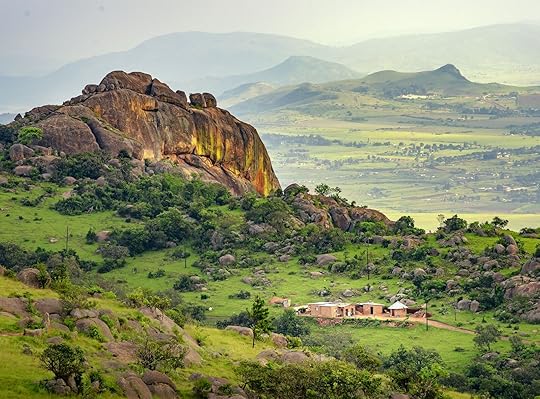
Photo: mbrand85/Shutterstock
The Kingdom of Swaziland changed its name to Eswatini in 2018. King Mswati III, the last absolute monarch in Africa, announced the news during a celebration of the nation’s 50th anniversary of independence from Britain. Eswatini translates to “land of the Swazis.”
4. CzechiaThough the UN has officially recognized the Czech Republic as Czechia since 2016, the new moniker has yet to catch on. Even the Czech Prime Minister, Andrej Babiš, needed a reminder in 2020 when, midway through an interview, he had to be informed of the name change.
“I didn’t know this. I don’t like it at all,” Babiš said in an interview with The Wall Street Journal, explaining his fear that the rebranding would create confusion between Czechia and Chechnya, a Russian republic. “We are Czech Republic,” he . “We are Czechs. And I don’t know who came [up] with such a stupid idea. Crazy.”
Evidently, the Czech president, Miloš Zeman, disagreed. President Zeman was among the most fervent champions of the catchier name, which unlike Chechnya is meant to be pronounced with a hard “k” sound in the center. Debates over what to call the Central European nation have existed at least as far back as 1992 when former Czechoslovakia split into the independent states of the Czech Republic and Slovakia.
Though President Zeman has stated his affinity for the short and snappy name Czechia, in part to distance the country from its Soviet past, the jury’s still out on whether or not Czech citizens and the global community will rally behind the new moniker.
5. Cabo Verde
Photo: Samuel Borges Photography/Shutterstock
Cabo Verde used to be known as Cape Verde. Then, in 2013, the West African island registered its name with the UN using the full Portuguese spelling, honoring the nation’s official language. The previous moniker was a linguistic hybrid, using “cape” as a the English translation of “cabo” but keeping “verde” as the Portuguese word for “green.” Unlike some countries that change their names, Cabo Verde altered both the long and short versions of its name, making its official title the Republic of Cabo Verde. 
Marriott Bonvoy is hiring 3 TikTok experts to travel the world and make videos

If you mastered the art of the one-minute video and have a love for travel (and have a bit of luck), you could end up enjoying luxury stays around the world courtesy of Marriott Bonvoy. The company is offering three TikTok experts 10 stays apiece in 30 hotels under the Marriott brands, including The Ritz-Carlton, St. Regis, and Marriott’s home rental brands Homes & Villas by Marriott International. Winners will become the company’s official TikTok correspondents, sharing their travel adventures around the world on TikTok.
@marriottbonvoy Travel & make TikToks. #30stays300days #contest ♬ I Just Wanna Know – Luke Reeves
Perks include roundtrip airfare; a $10,000 Marriott Bonvoy Gift Card to use for on-property meals, spa treatments, and other amenities and experiences; Uber vouchers; a personal travel concierge; progress in reaching Marriott Bonvoy Elite Status; and a “Take Me Away” travel kit with merchandise from the branded online retail stores on Marriott Bonvoy Boutiques. Winners will also get paid a $15,000 stipend.
To enter the 30 Stays, 300 Days giveaway, contest hopefuls must follow @MarriottBonvoy on TikTok. Then, those interested need to create a TikTok video with the hashtags #30stays300days and #contest that answers how travel has shaped them and explains why they should be one of the three Marriott Bonvoy TikTok correspondents. The contest ends on March 18, 2022. To enter, you must be 21 years or older. Travel on this journey begins in the spring. The full list of rules and regulations can be found on the #30stays300days contest page.
“Our goal with this initiative is to reignite the passion for travel in leveraging Marriott Bonvoy’s portfolio in a creative way with a digital-first mindset. Travel is without a doubt one of the strongest tools we have to bring people together, broaden horizons, and foster growth all with an unwavering spirit of curiosity,” said Brian Povinelli, Marriott International’s senior vice president of brand, loyalty, and portfolio marketing. “We’re excited for our TikTok correspondents to embrace the transformative power of travel and showcase Marriott Bonvoy as the vehicle to explore the world through this once-in-a-lifetime experience.”
More like thisSpirits + CocktailsHow a Marriott resort became Cancun’s best spot for mezcalWhat it’s like to be a 2022 Olympics ski patroller: quarantines, king-size beds, and 80 mph skiing

The olympic games don’t just draw the best athletes in the world — they also draw the best support staff in the world. And that includes the ski patrollers responsible for keeping more than 300 international athletes safe during Olympic ski events as they move at some of the fastest speeds the world has ever seen.
Being one of the world’s best ski patrollers isn’t a common job, especially as there’s no clear training path to the top like an athlete may follow. So we caught up over email with Bruce Welton, 37, a ski patroller at the 2022 Olympic Winter Games in Beijing, to find out what it’s like behind the scenes (and on the slopes) preparing for the upcoming Olympic ski events. Bruce has been in China since November 2021, teaching and training local ski patrollers on best practices for safety during the 2022 Olympic ski events in Beijing.
Everything below is Bruce’s personal take on teaching and traveling in China, not a reflection of any official stance from anyone affiliated with the Olympic Games (though it’s safe to say most people working the events are probably enjoying themselves). Some answers have minor edits for length and clarity.
Matador: Tell us about yourself, please
Photo: Bruce Welton
I’m Bruce and I live in Truckee, California. I’m a ski patroller in Lake Tahoe, and now, a ski patroller and ski patrol instructor in Beijing around the 2022 Olympic ski events. My primary responsibility has been to help train the local patrol team to make sure they’re able to handle any on-mountain medical responses, including patient care and transport.
Matador: How long have you been skiing? What’s your patrol experience?Unlike many others who love skiing and made it their career, I got a relatively late start. As a young boy, my father was a ski patroller, which naturally gave me plenty of opportunities to ski. But as my mother puts it, I had no interest in skiing and my parents didn’t push it on me — for that, I thank them.
So I wasn’t on skis until age 12, straight-lining down a small hill in Pennsylvania. I had straight skis and my jacket fully unzipped, waving behind me like a Superman cape. I most likely had a goggle gap of some extent and no clue how I was going to stop. But that day I absolutely fell in love with skiing. There is something magical about the feeling of sliding on xue (Chinese for snow).
As a teenager, I skied as much as possible. From skiing with my father, I quickly learned what ski patrollers are and what they do. I thought they had the best job on the planet. I was convinced of it. And since then, I’ve learned that I was correct.
Living and going to school in Killington, Vermont exposed me to the ski industry in all of its glory. I quickly found out that joining the ski patrol may not be as unattainable as I once thought and eventually made it as a rookie patroller (minus the goggle gap) in 2009.
Since then, I’ve patrolled at Heavenly Resort (South Lake Tahoe, California) and present patrol at Palisades Tahoe (formally Squaw Valley). Patrolling at Palisades Tahoe gave me the opportunity to patrol at Mount Buller, Australia [a partner resort of Palisades Tahoe] and, now, the 2022 Winter Olympics in Beijing.
Matador: How did you become an Olympic patroller? What was the application process like?As with many things in life, it’s about who you know. I have a good friend, Kari, who runs the Association of Professional Patrollers. Through there, she met Ed Gassman, who has been in charge of assembling the international ski patrol team for the past 20 years. She told me Ed was working on the team for Beijing and to contact him if I was interested. She also vouched for my experience and qualifications with Ed. Six months later, I was on an airplane to Beijing.
Matador: When did you get there? Did you quarantine? How long will you be there?I flew from LA to Beijing on November 14 and spent 21 days in quarantine in a hotel in Tianjin. It was a requirement for everyone entering the country and pretty strict — I wasn’t allowed to leave the room. I plan on being here through the Paralympics and heading home on March 15.
Matador: What is a normal pre-Olympic day like for a ski patroller?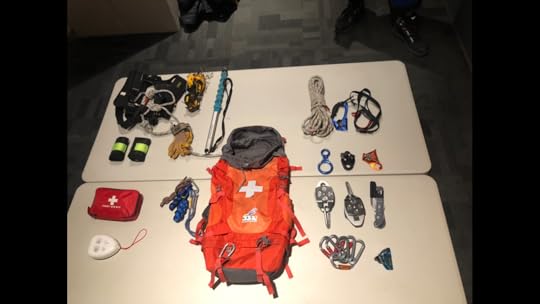
Photo: Bruce Welton
Our primary focus is preparing the local patrol team for emergency response, patient care, and transport. We practice unique situations such as skiers entangled in safety nets and safely conducting rescues on a water-injected snow surface [a very icy, slick layer of snow designed to maintain speed and shape despite heavy use]. Rope-assisted rescues, helicopter extraction, and toboggan-handling techniques are also incorporated into our days.
Outside of that, mountain and course safety for the 2022 Olympic ski events is our priority. The trails are covered with miles of safety nets and pads. We spend time making sure they are properly installed and in the correct places in order to work effectively if needed.
Matador: What do you expect your days to be like during the actual games?A successful day will actually start the day before. We’ll be given a detailed weather briefing, discuss any concerns, and highlight the positives. The morning of the games, we assign the patrols, go over timing for training and events, and discuss any changes in the original plan. The day is general spent responding to medical needs and being prepared for anything.
Matador: Is being an Olympic patroller different from being a Palisades/”regular” mountain patroller?
Photo: Dustin Satloff/US Ski Team
In some sense, yes. We don’t have the concern of thousands of random skiers getting themselves into bad situations, nor do we have the challenge that comes with significant snow. This venue is strictly a race venue. We may not see as many injuries, but the ones we see can be serious. [Editor’s note: athletes completing in the Olympic Games Super-G event can regularly reach speeds of 85 miles per hour.]
Matador: How many of you are on the team? Does everyone speak English?The international patrol team has two primary groups. I am part of the training team (myself and three other Americans) who arrived in November to help prepare the local patrol team. Starting on January 23, 22 additional international patrollers will arrive from around the world to support the local team and meet the FIS [International Ski Foundation] requirement for minimum number of rescue personal on the mountain. It’s a group of men and women coming from six additional countries plus China, and I believe most people will speak a basic level of English to help us communicate on the mountain.
Matador: Tell us about the resort. What’s it like?Events are at the National Alpine Ski Center (NACS), a custom-built alpine race venue in Yanqing. It has separate base lodges, five gondolas, four chair lifts, and three surface lifts. There are separate slopes for the technical events (slalom and giant slalom) and speed events (Super-G and downhill) and each has at least one training run plus the official race course. There’s a separate venue at an already existing resort (Genting Snow Park) for events like halfpipe and slopestyle.
Matador: Where do you stay? Do you socialize with other staff? Athletes? What’s it like behind the scenes?We’re in Yanqing, 1.5 hours north of Beijing. We’re actually in a beautiful five-star hotel: the Crown Plaza. Living in a hotel for months sounds like a nightmare but the extended stay is just part of the deal (imagine the reward points!) I consider it my massive 200-room house. I share a restaurant/dining room with lots of friends, we have several different lounges to kick-up our feet, and a fitness center to burn off the occasional beer(s). When the day is done, I retreat to my private room with a king-size bed, walk-in shower, soaking tub, cozy couch, and office space.

Photo: Bruce Welton
I’m in the same hotel with snowcat [snow grooming machine] operators and race crew. We have the opportunity to go out to dinner as often as we would like. Days off are a balance between soaking in the local area, taking care of laundry, and recouping from a long week. Sites like the Great Wall of China are only a 15-minute cab ride away and there are endless restaurants and shops within walking distance of the hotel. Lodging and meals are included as part of our compensation, so we only have to cover our expenses if we go out to dinner.
Matador: What has been your favorite thing about China so far? What surprised you the most?The excitement that surrounds the Olympics speaks for itself. Being involved in the Olympics is about the connections with the people of China and the world. This experience is about the memories of teaching locals basic English, learning about the culture, and eating unfamiliar foods. It’s about sharing a part of my life that I love so much with great people halfway around the world. Doing so in a different language and remembering that as much as I am here to teach them ski skills, they can teach me even more.
Matador: What comes next? Will you start ski patrolling at all Olympics? Come back to your home mountain?I have made some incredible connections in China, and the winter games of Italy in 2026 are certainly on my radar, but it’s too early to tell. For now, I’m looking forward to a couple days of rest and relaxation, time spent telling stories and catching up with the ones I love back home. I plan on having an amazing spring season with the Palisades Tahoe Ski Patrol, sharing this incredible journey and hopefully inspiring others to adventure whenever they have the opportunity. 
The most scenic and luxurious train rides in the world, according to the Man in Seat 61

When we imagine the future of travel, we likely picture robot concierges at hotels, contactless checkpoints at airports, and flying taxis. Train travel, however, probably isn’t top of mind. Traveling by train, especially in the US, feels more like a nod to the past loaded with novelty and nostalgia, but not necessarily efficiency, beauty, or luxury. That’s all changing.
Sure, trains are a classic example of the old cliche: “It’s about the journey, not the destination.” But they’re more than just a scenic alternative to airplanes. As travelers become increasingly conscious of their carbon footprint, train journeys remain the leading option for a more sustainable trip. The emergence of more sleeper trains in Europe, and the expanding US rail network, also points to a revival of train travel.
The state of train travel is so exciting, in fact, that some choose to make a living by riding the rails.
The Man in Seat 61 has turned train travel into his way of life. A former station manager for London’s Charing Cross, London Bridge, and Cannon Street stations, and various other jobs in the rail industry, he now travels the world by train and runs a popular blog detailing his journeys. His blog, The Man in Seat 61, aims to inspire people to forego the cold, uninspiring airport experience for a more scenic and sustainable trip. We spoke to the Man himself to get his insights on the best train rides in the world, and what the future of train travel looks like from his expert point of view.
So, why do you like trains so much?Travel isn’t just about a destination, it’s about the journey. When you travel by train and ship you see where you’re going, you’re a participant in the country you’re visiting rather than a mere spectator. [The railway companies] treat you like a human being, with room to move and stretch out, sleep in a bed in your own room, eat in a restaurant.
Do you still fly, or do you stick to trains?I don’t fly at all within Europe, or once I reach a long-haul destination. I fly long-haul if I have to, maybe every few years from the UK when visiting places such as Sri Lanka, Vietnam, or Indonesia.
What do you look for in a good train ride, and what separates a good experience from a bad experience?Sometimes, a great journey is about the train itself, the comfort of the sleepers, dining facilities, and in some cases even lounges. Sometimes, it’s about the landscape and scenery through which you pass. Sometimes, it’s about the things that happen and people you meet along the way. And sometimes, even a superficially bad experience can be good, like travelling on a third-class slow train from Aswan to Luxor, delayed, hot, dirty and dusty with broken seats and windows. Talking with the locals and helping some school kids with their English homework is something I’ve never forgotten. What a ride!
The real enemy of travel isn’t the possibility of bad experiences, it’s the temptation to forego all and any experience because flying is superficially cheap and easy.
What’s the most scenic route you’ve ever traveled?Tough one! How does one compare a seven-hour journey through the Swiss Alps on the wonderful narrow-gauge panoramic Bernina Express with the day-long ride through Serbia to the mountains of Montenegro on the spectacular Belgrade-Bar line? Or a 48-hour journey from Chicago to San Francisco on Amtrak’s California Zephyr, across the Nebraska flatlands, over the Mississippi, up into the Rockies, along those Colorado canyons, and into the Sierra Nevada via the infamous Donner Pass? There are so many train rides that are scenic in their own unique way.
What’s the most luxurious train you’ve ever been on?I got engaged (without planning to, what can I say, that train weaved its very special magic) on board the Venice Simplon Orient Express from London to Venice. But that’s classic 1920s luxury, meaning washbasins in each compartment (there were no en suite toilets and showers in carriages built back then). So, my best, most luxurious train ride has to be South Africa’s superb Blue Train from Cape Town to Pretoria, with windows tinted with real gold to keep down the glare, and even complimentary Montecristo cigars in the bar car. It’s the only train on which I’ve ever had a bath (as opposed to shower) in my private bathroom. Surprisingly, at 50 mph on 3’6″ gauge track the water slopped about much less than you’d think.
Train travel for leisure trips is far more ubiquitous in Europe than in the US. Why do you think this is?Back in the 1930s, 40s, and 50s, America had modern diesels and gleaming stainless steel streamliners with vista-domes while we here in Europe were still building steam engines. What went wrong? The US became the land of the airliner and automobile, and rail was almost abandoned other than (by European standards) a skeleton network. But Amtrak still covers the whole country, and for visitors it’s a godsend. We can travel coast to coast at ground level seeing America up close and personal, without flying over it all and missing everything, or having to drive thousands of miles.
How do you envision sustainability impacting the future of train travel vs. flying?I’ve seen a real change over the last few years leading up to the pandemic. I first started the blog in 2001, and back then, if someone told me why they were traveling by rail instead of flying from, say, London to Italy, they’d typically say they were afraid of flying, medically restricted from flying, or just knew they particularly liked trains. Now, they say two things in the same breath: They are fed up with the stress of airports and flights and they want to cut their carbon footprint. This has come from the grass roots, certainly not from train operators. It’s now been picked up by the media, and finally politicians are beginning to notice.
In Europe at least, people are starting to avoid flights and switch to rail for increasingly long distances. It’s even led to a resurgence in sleeper trains, where rail can provide a realistic alternative to a flight even for 500-700-mile trips. I expect this will continue. My message, of course, is that in taking a train instead of flying you’re not just doing the planet a favor, you’re doing yourself one!
What’s the best train ride you recommend everyone take at least once in their life?If you live in the States, ride Amtrak’s California Zephyr between Chicago and San Francisco. Indeed, if you book ahead as little as $200 will get you coast to coast, one of the world’s greatest train trips and one of the world’s greatest travel bargains. Over the years I’ve crossed the US six times by rail, once by road, and this is the most scenic of all Amtrak’s trans-continental routes.
In Europe, ride the Bernina Express from Chur to Tirano. It’s the most scenic of all the Alpine rail routes, and with a train connection from Tirano to Milan it’s the scenic slow route to Italy, too.
When it comes to the future of train travel, what are you most excited about?The resurgence of sleeper trains. It’s like watching your favourite team seriously down at halftime, then fight back and win in the second half! Paris-Vienna and Amsterdam-Switzerland were restored a couple of weeks ago. A new company, European Sleeper, will start a sleeper train from Brussels and Amsterdam to Berlin and Prague this summer. I hope to ride their first one. Austrian Railways (OBB) has new sleeper trains under construction – all sleepers with en suite toilets and showers. Their biggest innovation, however, is private capsules called “minisuites” providing a bed and a private space at economy prices. I hope OBB will let me visit Austria later this year to see them being built. 
10 hotels with special proposal packages that will de-stress your engagement

Whether you’re the next Rico Suave or asked coyly by Grandma every Thanksgiving if she’ll ever have grandbabies, chances are you’ve daydreamed about your future proposal. What will go down–quite literally — the day you hear these four petrifying yet glorious words: “Will you marry me?” But things have gotten a tad more complicated since dad wowed mom with some store-bought chocolate and cheap wine after proclaiming his adoration and proposing some decades ago. We live in a time where out-of-the-ordinary proposal packages are the norm and will most likely be immortalized forever on social media. Sound like high pressure?
“Proposing is one of the most nerve-wracking moments in your life, even if you know your partner is going to say yes,” says Kara Harms, travel blogger at Whimsy Soul. “Throw in logistics and getting all the little details right in a location you aren’t familiar with, and it can be paralyzing. My husband admitted he held off proposing for months just because he wasn’t sure how to do it.”
Luckily, we’ve gathered some of the world’s finest hotel proposal packages deliberately designed to alleviate stress while still giving you all the credit in BAE’s eyes.
Why does proposing on the road require that extra help? “When traveling, you’re a visitor and have less familiarity with the locale that’s different from your home,” explains Brandon Berkson, founder of luxury hotel concierge Hotels Above Par.
“Let your host, the hotel, ensure everything is seamless and taken care of, from start to finish. In the end, you don’t need to be a hero. Have someone help you with the proposal process when on holiday.”
Below is our selection of 10 hotels and resorts with unique proposal packages that make asking that anxiety-inducing question a whole lot more memorable — and a bit more manageable!
We hope you love the spaces we recommend! Just so you know, Matador may collect a small commission from the links on this page if you decide to book a stay. Listed prices are accurate as of the time of publication. See our full Advertiser Disclosure here.
1. The Marquette Hotel — Minneapolis, Minnesota
Photo: The Marquette Hotel
Bachelorette fans may recognize Minneapolis’ The Marquette Hotel as the heavily-featured hotspot of a recent season. A spot romantic enough for reality TV in this Midwestern hidden gem also dazzles commoners with the “Say ‘I Do’ with a View” package. This unique proposal package takes engagements to literal new heights at the iconic Windows on Minnesota, a venue proudly perched on the 50th floor of the city’s IDS center, with birds-eye views of the downtown cityscape, a backdrop of twinkling lights setting a sexy ambiance.
No details are left spared; the couple will celebrate with a bottle of Champagne and a complimentary night in one of the hotel’s guest rooms. Romance connoisseurs can purchase add-on indulgences, including an upgrade to one of The Marquette’s luxuriously-appointed suites, chocolate-covered strawberries, rose petals, candles, or even a professional photographer to capture the magic.
Price: The “Say ‘I Do’ with a View” package starts at $500.
2. Emerald Maldives Resort and Spa — The Maldives
Photo: Emerald Maldives Resort and Spa

Photo: Emerald Maldives Resort and Spa

Photo: Emerald Maldives Resort and Spa
We get it: it seems pretty overwhelming to figure out where to propose in the Maldives, that picture-perfect archipelago of islands in the Indian Ocean. Luckily Emerald Maldives Resort and Spa takes the lead with their curated proposal packages.
Before the trip, guests will be connected with the savvy Engagement Concierge to map out their dream proposal. The groom-to-be will be whisked on a tour of the island to decide on a perfect location–whether it’s a private, candlelit dinner on the beach or while exploring the circus of marine life on a snorkeling excursion.
Especially romantic setups include an underwater diving proposal and a private cinema showing on their pristine beach and if said video is of your dearest memories together, please bring extra tissues.
Price: The Engagement Concierge is at no extra cost, and the activity cost varies.
3. Six Senses Zighy Bay — Musandam Peninsula, Oman
Photo: Six Senses Zighy Bay

Photo: Six Senses Zighy Bay
You’ll forget about the proposal butterflies when 960 feet above sea level, flying like the native hawk over Oman’s dramatic and verdant mountain range. Six Senses Zighy Bay, a bespoke village-inspired Omani resort, is nestled in the jagged coastline of the Musandam Peninsula. And while the five-star property is metaphorically jaw-dropping, their “Paraglide Proposal” package quite literally is.
Here’s the nitty-gritty: One minute, the future betrothed is on the launch pad at 960 feet above sea level, and the next, they’re enjoying panoramic aerial views of the Al Hajar Mountains, the expansive Gulf of Oman, and even some ancient fishing villages sprinkled in. As they come to descend with a soft landing on the pristine white sands of Zighy beach below, their soon-to-be fiancé will be bearing a “Will you Marry Me?” sign made of sticks and stones on the beach, of course, with Champagne to follow.
Price: The “Six Senses Zighy Bay’s Paraglide Proposal” package starts at $2600 for accommodations and the paragliding experience.
4. Four Seasons St. Louis — St. Louis, Missouri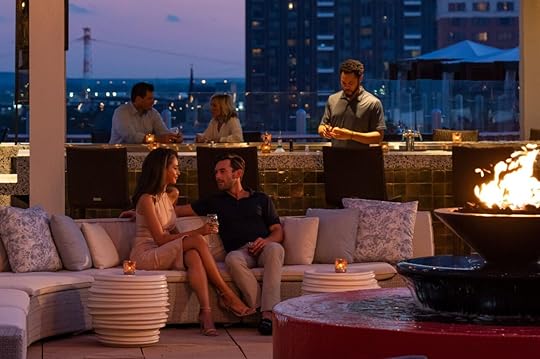
Photo: Four Seasons St. Louis

Photo: Four Seasons St. Louis
Four Seasons St. Louis will ignite sparks quite the literally. The five-star property’s Sky Terrace rooftop stretches eight stories above this Midwestern metropolis, looking out over the storied Mississippi River, with that shiny Gateway Arch always in view. This romantic perch is the ideal spot to pop the question, as fireworks burst against a backdrop of wide-open skies and the shimmering edifice (cue Katy Perry). As if your own fireworks aren’t extra enough, the entire experience can be customized to include Champagne, music, and flowers.
Price: An hour-long proposal experience with fireworks begins at $4,000.
5. Kimpton The Rowan Palm Springs — Palm Springs, California
Photo: Kimpton The Rowan Palm Springs/Laure Joliet

Photo: Kimpton The Rowan Palm Springs/Jakob Layman
Palm Springs may be associated with golf retirees and overpriced health retreats, but it’s also the unconventional romance spot you’ve been looking for. The Kimpton The Rowan Palm Springs “Just Say Yes!” package brings romance to literal new heights, as the hotel’s rooftop is the regions’ tallest building — and lest we forget the view of the San Jacinto Mountains and desert landscape from above the forest of palm trees!
Following the Q, couples can celebrate with a bottle of Veuve Clicquot and a dinner for two at their otherworldly rooftop, 4 Saints. Of course, a personal photographer is on hand to capture the (hopefully) affirmative response, and the hotel suggests you book a night in one of its lavish suites to get jiggy with it afterward.
Price: The “Just Say Yes!” package starts at $1,400 per person.
6. The London West Hollywood at Beverly Hills — Los Angeles, California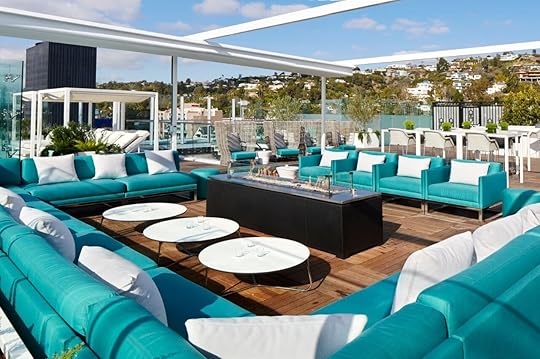
Photo: The London West Hollywood at Beverly Hills

Photo: The London West Hollywood at Beverly Hills
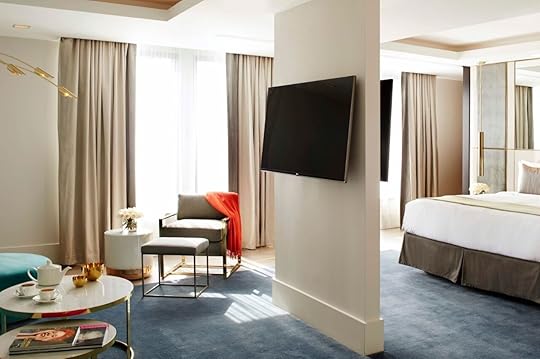
Photo: The London West Hollywood at Beverly Hills
We wouldn’t expect The City of Angels to serve anything less than over-the-top extra-ness…ever. And The London West Hollywood at Beverly Hills, an urban recluse frequented by many A-listers, certainly doesn’t disappoint with their engagement experience. You and your darling will have intimate access to the property’s rooftop — an 11,000-square-foot Penthouse Suite. Even more, the hotel provides a confidential consultation with a gemologist from VRAI, inviting your future mate to fawn over and be fitted for their engagement ring. Of course, the celebration will continue, with an overnight stay in one of the hotel’s suites, in-room Champagne, and desserts in the shape of VRAI diamond jewelry.
Price: The package is entirely customizable, depending on the desired premier suite and VRAI diamond budget.
7. The Augustine Hotel — Prague, Czech Republic
Photo: The Augustine Hotel
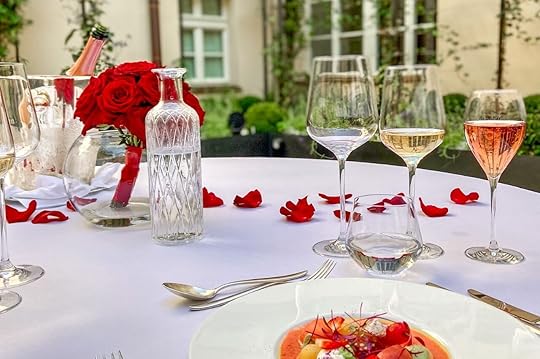
Photo: The Augustine Hotel
Prague, taking the superlative for Europe’s Most Romantic City with its embellished castles and ornate building, is an obvious overseas destination proposal chosen for intrepid lovebirds. And The Augustine Hotel, a former monastery turned luxury retreat minutes from The Charles Bridge, delivers the pinnacle proposal package. In warm weather months, lovers will be ensconced by flowers in the hotel’s tucked-away rose garden. While indulging in the six-course tasting menu for two, premium wines and Perrier-Jouët Champagne, the darlings will be treated to a live music performance of their choice. Of course, a proposal in a rose garden necessitates a bouquet of roses (provided by the hotel — don’t worry!) to bestow upon your future wife afterward. Because we all know Thomas Holcroft was correct when he said that both “love and a red rose can’t be hidden.”
In Prague’s more moody winter, the proposal dinner is moved into a private dining room with a cozy fireplace in the fairytale suite. The quintessential ending to your fairytale proposal is staying in the hotel’s Tower Suite, formally an astronomical tower, with a panoramic 360-degree view of Prague. Move over Kate and William — this is how the real royals do it.
Price: The package is around $1,170 for two people.
8. The River House at Odette’s — New Hope, Pennsylvania
Photo: The River House at Odette's

Photo: The River House at Odette's

Photo: The River House at Odette's
You and your sweetheart will be feeling the heat quite literally with the “Fireside Proposal Package” at The River House at Odette’s, a charming boutique hotel anchored on the Delaware River in New Hope, Pennsylvania. The property boasts a fabulous covered outdoor space, Odette’s Overlook, with sweeping river vistas and an oversized stone fireplace for sipping cocktails on chilly nights.
This proposal package, which can be booked in winters from January until March, is the ultimate choice for nature-aficionados seeking something rustic yet romantic. It includes private sunset cocktails and canapes at Odette’s Overlook fireplace (hello, hot romance!) A photographer will be hidden to capture the proposal, and Champagne is chilled and waiting for a congratulatory toast afterward.
The heat continues afterward with a congratulatory dinner at ROOF, their exclusive, private members-only club open to overnight guests at the hotel. You can cozy with your lovebird overnight at one of River House’s premier suites, complete with a roaring fireplace and a dozen roses. We’re getting hot just thinking about it.
Price: Varies, depending on how comprehensive package is.
9. Ritz Carlton Orlando, Grande Lakes — Orlando, Florida
Photo: Ritz Carlton Orlando, Grande Lakes
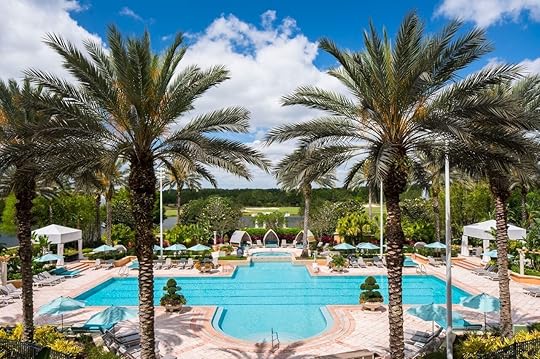
Photo: Ritz Carlton Orlando, Grande Lakes

Photo: Ritz Carlton Orlando, Grande Lakes
Orlando is more than fanny packs and oversized Goofy t-shirts. It’s actually quite the romantic town, and nowhere is that epitomized more than the Ritz Carlton Orlando, Grande Lakes 10 minutes from the commercial action of the city and two minutes from the natural action of the surrounding sunken wetlands.
Though there is a vast variety of intimate proposal settings on the resort’s 500-acre property, the sunrise swamp boat trip may be the most memorable. Okay, while boglands saturated with alligators, snakes, and other vile rodents (oh my), may not initially seem like the fairytale proposal location, the Ritz somehow creates a fairytale experience grander than neighboring Disney World.
Here’s how it works: A golf buggy will pick you both up from the hotel, swerving through the property and to your chariot AKA a two-person canoe on the marshy river (and we promise you won’t be fighting off crowds here!) The enchanting Everglades your backdrop, we can almost hear cartoon Louis a la Princess and the Frog serenading you as you get down (metaphorically — tipped canoes aren’t sexy) and propose.
Continue the post-proposal abundance of aphrodisiacs at the hotel’s famed restaurant, Knife and Spoon, conceived and led by award-winning Chef John Tesar, with a menu created with local ingredients found on the property.
Price: The cost varies depending on the time of year, chosen room, etc.
10. Napa River Inn — Napa, California
Photo: Shutterstock/Cheng Cheng
There is nothing like a glass of bubbly (or six) to calm those pre-proposal jitterbugs. Napa Valley, long revered as the ultimate romantic getaway for wine connoisseurs and gourmands, has long been a popular proposal spot. However, Napa River Inn, Downtown Napa’s highest Michelin-rated hotel, is particularly adorable with its “I Will” package (not to be confused with its equally eccentric “I Do” package for newlyweds.)
One of the hotel’s top concierge associates will be available to direct you to Napa Valley’s most romantic spots. Most unique in the “I Will” package is the optimal excitement of a customizable flash mob proposal along the Napa River. The couple can enjoy four nights in a romantic suite at the hotel with breakfast in bed, rose petals, fresh flowers, chocolate, and special linens as well. Lastly, the package includes local Napa Valley-produced diamond ring selection and delivery. No detail — or grape — is spared in this comprehensive package.
Price: The cost of the “I Will” package is $6,500, not including the cost of the ring. 
Matador Network's Blog
- Matador Network's profile
- 6 followers



